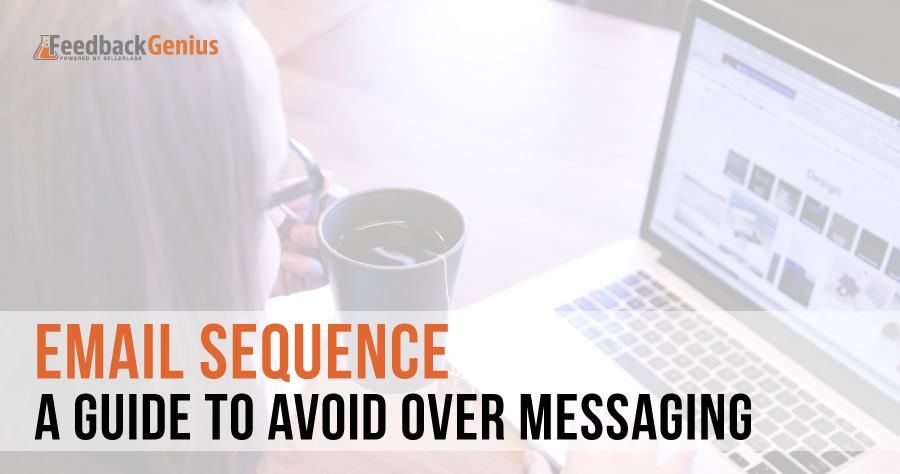Amazon Email Sequence: A Guide to Avoid Over Messaging

I communicate with sellers on a daily basis. I find it deflating when I see poor reviews on an account because a seller is sending too many emails. But this can be easily avoided. Sending more than three emails to your customers may be doing more harm than good to your Amazon feedback and reviews. In this post I’ll provide you with an email sequence guide to avoid over messaging shoppers to help you get more traction with your emails for increased reviews. Before I get started, though, understand that there are exceptions to this guide. Not every seller who’s sending proactive, helpful messages–even if it is three or more–is getting negative responses to their emails. Some sellers use three messages or more in a sequence that works great for them and they get positive responses. The key to a successful message sequence is setting a goal, the frequency and the email copy.
Step 1: Setting a Goal
When creating your messages, it’s best to put yourself in the shoppers’ shoes. I don’t sell on Amazon but I do make frequent purchases. Therefore, I consider myself the target audience for feedback and product review messages. Before you ever start writing a message, you need to determine what your goal is. Is it to:
- Get product reviews
- Ask for a seller feedback
- Open a line of communication for customer service
- Alert the customer that a product has shipped, on its way, or has been delivered
- Or just to thank them
Once you’ve established a goal for your email sequence, you can now determine what your message frequency will be.
Step 2: Message Frequency
Let me start with an example. Let’s say I bought something and a seller is sending four to five messages in a sequence for that particular order:
- Message 1: “Your order has shipped”
- Message 2: “Your order is almost there”
- Message 3: “Your order has arrived; leave us feedback/product review”
- Message 4: “It’s been a couple of days since your order arrived; leave us feedback/product review”
In addition to the messages listed above, I’m probably still receiving two to three automated emails from Amazon. To my knowledge, Amazon sends out three emails when an order is placed: An order confirmation email; a shipment confirmation email; and a possible feedback or review request email 10-15 days after delivery.
If this scenario were real–which is quite possible–I would have received seven to eight emails within a short amount of time for one order. In the customer’s perspective, this could be considered spam. I don’t think anybody would want to receive this many emails even if they purchased a new Apple computer or car.
An easy way to accomplish the right message frequency is to map out your emails on a whiteboard, piece of paper or with a software program so you can visually see what is going out and when. Each email sequence needs to be made with your goal in mind and accomplished with the least amount of messages possible. I’ll give you an example of the three steps together at the bottom.
Step 3: Message Copy
Now that you’ve determined a goal and frequency, you’re ready to write the actual emails. This can be difficult if you’re new to this sort of thing, but my basic rule is to keep it short and simple. Remember, if you’re not bombarding people with messages somebody else probably is. This means you have a limited amount of time to get a buyer’s attention. The majority of people will give your message a two-second glance and up to eight seconds if they skim read it.
Depending what your goal is for the message sequence and where a particular message falls within the order, you’ll want the message to communicate one point or call to action (CTA). For example:
- “Your order is in route”, CTA: Include a tracking number for the package.
- “Your order has arrived”, CTA: Customer service link to your email.
- “It’s been a couple of days since order arrived”, CTA: Link to product review on Amazon.
When writing your messages’ content, use basic language that communicates exactly what you want the buyer to do. Short and easy-to-read sentences will maximize the engagement you get with your emails. Keep the length to three to four sentences at most, or just one short paragraph. There’s no need to explain how great your product is because the customer has already purchased your product. Add some personality to your messages. People respond better to messages from actual people than bland, corporate-sounding language.
Step 4: Putting It All Together
Everything is now in order to get your email sequence out the door and running. Let’s put it all together with an example of what an ideal sequence looks like. I recommend sending two emails per order but you can send three if you think it’s necessary.
- Email Option 1 (send this or option 2): “Your order is almost here”
- Goal: Excite the customer to make the product top of mind.
- Copy: Your order is almost here. Waiting really is the hardest part but it’s all worth it when you unbox your shiny new purchase. We don’t want to keep you, just thought we’d give you a quick update.
- Email Option 2 (send this or option 1): “Your order has arrived”
- Goal: Open a line of communication for customer service.
- Copy: In case you haven’t heard, your product just arrived! We know you’re going to be busy trying it out and showing it off to your new friends, but if any problem should arise, contact me so we can get things straight.
- Email Option 3 2-7 days after delivery (this message is the bread and butter of the sequence): “It’s been a couple of days since your order arrived”
- Goal: To solicit a product review.
- Copy: I haven’t heard from you so I’m guessing you love your new product. Shoppers who love their products, like you, help make educated decisions for others. If you could take 5 to 10 minutes to review your product that would mean the world to me and others.
Tip: Use Feedback Genius’s “Delivered Within” filter to ensure this email doesn’t get send to an order that was delivered late.
Conclusion:
Creating the perfect email sequence is a process. Keep in mind who’s buying your products and what kind of products you’re selling. This will give you a great baseline to help you start creating sequences. Remember to keep your emails short and concise. Write meaningful messages to your customers. And if you just read one or two sentences of this post, let it be this:
Avoid sending more than three emails to your customers. The risk of sending three or more messages soliciting feedback or reviews can turn off customers to receiving requests altogether!

Brandon is one of the co-founders, CEO, and main data geek for Seller Labs. He started Seller Labs after finding no other tools that could provide the flexibility needed for his used-book business. He no longer sells online, but now guides Seller Labs as the lead innovator to make sure that our products remain on the cutting edge.






